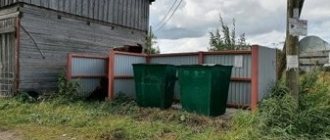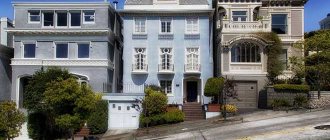There are two ways to determine the value of ODN in an apartment building: using a common building metering device and according to the standard. Below are examples of calculations for each case:
If there is a collective (common house) metering device in an apartment building
The volume of electricity provided during the billing period to the distribution network in an apartment building is in this case determined as the difference in the volume of electrical energy supplied to the apartment building and consumed by the owners (users) of residential and non-residential premises, which is distributed among consumers in proportion to the size of the total area of the premises owned by each consumer in an apartment building. Calculation of the amount of electricity payment for the billing period on a single-apartment building is carried out as follows (for example): 1. The volume of consumption is determined by the common building meter of an apartment building. Let’s say the volume of electricity determined from the readings of a common house meter was 4120 kWh; 2. The volume of electricity consumed by the distribution center of an apartment building is determined. Let us assume that the total volume of electricity consumption (according to meters and according to the standard) in residential and non-residential premises of the house was 3280 kWh. Then the volume of electrical energy consumed at the distribution center of an apartment building will be: 4120-3280 = 840 kWh; 3. The volume of electricity on one unit per apartment is determined: let’s say the area of your apartment is 44 sq.m/2766 sq.m (total area of all residential premises (apartments) and non-residential premises in an apartment building) * 840 kW*h = 13 kW* h; 4. The amount of payment for one-way service is calculated: 13 kW/h * 4.32 rubles/kWh = 56.16 rubles. At the same time, 4.32 rubles/kWh is a one-rate tariff for residential premises in a gasified apartment building, current for the first half of 2020 (Order of the Volgograd Region KTR dated December 20, 2019 No. 44/2). Thus, due to the fact that the volume of electricity consumption in the premises of an apartment building is different every month, the amount of payment for ODN per residential/non-residential premises will also vary every month. Regulatory framework: - clause 44 of the Rules for the provision of utility services to owners and users of premises in apartment buildings and residential buildings, approved by Decree of the Government of the Russian Federation of May 6, 2011 No. 354 “On the provision of utility services to owners and users of premises in apartment buildings and residential buildings."
If there is no collective (common house) metering device in an apartment building
The volume of electricity provided for the billing period to the distribution point in an apartment building is in this case determined as the product of the standard for common building needs by the area of common property with subsequent distribution among consumers in proportion to the size of the total area of the premises belonging to each consumer in the apartment building.
Calculation of the amount of electricity payment for the billing period for the one-room supply network is carried out as follows (for example): 1. Determine the value of the standard for the one-room supply network for an apartment building. Let's say the house is equipped with an elevator and is not equipped with electric heating and electric heating units for hot energy supply, then the standard will be equal to 2.6 kWh per month. per sq.m (Resolution of the Ministry of Fuel and Energy Tariffs of the Volgograd Region dated July 30, 2012 No. 5); 2. Total area of premises included in the common property in an apartment building = 320 sq.m; 3. The volume of electricity per unit per apartment is determined: 2.6 kWh per month. per sq.m * 526 sq.m * 44 sq.m (total area of the apartment)/2766 sq.m (total area of all residential premises (apartments) and non-residential premises in an apartment building) = 22 kWh; 4. The size of the fee for one-way service is calculated: 22 kW/h*4.32 RUR/kW*h = 95.04 RUR. At the same time, 4.32 rubles/kWh is a single-rate tariff for residential premises in a gasified apartment building, valid for the first half of 2021 (Order of the Volgograd Region KTR dated December 20, 2019 No. 44/2). When calculating ODN in an apartment building that is not equipped with a common building metering device, the readings of consumers' electricity meters, as well as the consumption of residential and non-residential premises determined by calculation methods, are not included. Regulatory framework: - clause 48 of the Rules for the provision of utility services to owners and users of premises in apartment buildings and residential buildings, approved by Decree of the Government of the Russian Federation of May 6, 2011 No. 354 “On the provision of utility services to owners and users of premises in apartment buildings and residential buildings."
The calculations use information about the areas of an apartment building, according to technical passports (explications) produced by the BTI, information about the areas of apartments - according to the technical passports of residential premises. If the area information used in the calculations is incorrect, please notify the guaranteeing supplier. The monthly calculation of your ODN volume and its breakdown are indicated in the sent payment document for the corresponding billing period.
Why did the Ministry of Construction need clarification and to whom are they addressed?
The Ministry of Construction began to provide clarifications regarding the calculation of fees for common household needs back in December 2021 in the form of letters.
Many subsequent clarifications were clarifications of the first ones, etc. This did not make the questions any less. However, as for the residents, they were mostly interested in only one thing - a not very clear increase in the payment for one-time service, and in some cases by a significant amount. As defined in regulatory legal acts and primary clarifications of the Ministry of Construction, it is impossible to charge more for ODN than provided for by the standards. But, unfortunately, nowhere does it say that a smaller payment is allowed. Other problems arose. In some regions, the approval of standards is delayed, and therefore management companies began to apply standards many years ago. In some regions, already approved standards are being repealed, including situations where this is done at the request of the prosecutor’s office, which creates confusion. Many management companies and homeowners associations simply do not know how to make calculations correctly and how to interpret the laws, which is why they make calculations based on the principles of “as understood” and “as profitable.”
As a result of the resulting confusion and lack of unity in understanding the new order, ordinary citizens suffered, as always. In its next letter of clarification, the Ministry of Construction was already forced to clearly define: residents cannot pay more than what is determined by the standard, but they can pay less. At the same time, instructions were given to restore order in the regions with regulatory regulation and implementation of legislative requirements.
Calculation methodology
The amounts in the bills directly depend on the availability of communal measuring equipment. Collective meters allow for accurate accounting of resource consumption. This means that people only pay for the services they use. If there are counters, calculations are made as follows:
- Readings are taken from the collective device and the amount of resource consumed per month is determined.
- The volume used by the apartments is subtracted from the resulting figure.
- The result is divided between owners and tenants.
Hint: if the building has apartments without meters, then they are calculated according to the consumption rate.
In the absence of a collective metering device, calculations are made according to consumption standards. The result depends on the area of the common space and tariffs. Payment is divided between people taking into account the area of occupied premises.
Additional volume
Citizens take readings from metering devices at different times. This is taken into account in the calculations. That is, the method described above is a diagram. When determining charges, a special formula is used to take into account the average indicator established based on available data.
For information: if you take readings from metering devices at the same time, the charges will decrease.
What happens if you don't pay
The legislation clearly states the obligation of citizens to pay ODN. In addition, there are rules for holding non-payers accountable. The methods are:
- Accrual of penalties. This is carried out from the 31st day from the date of mandatory deposit of funds. And the latter is set until the 10th day of the month following the period of use of the services.
- Warning about disconnection from communications.
- Filing a claim in court.
The statute of limitations for utility payments is three years. Therefore, the management company will not delay for long in going to court. After all, in three years the debts will have to be written off.
What the law says
The maintenance of the common space of an apartment building is regulated by the following regulations:
- Housing Code (Article 156);
- Decrees of the Government of the Russian Federation: No. 354 of 05/06/11;
- No. 344 dated 04/16/13.
In Article 156 of the Housing Code, the obligation to repay the costs of ODN is assigned to tenants and owners of premises. The calculation procedure is deciphered in Resolution No. 354. And in document number 344, the Government of the Russian Federation established restrictions on the amounts accrued. They are:
- payment cannot exceed a certain threshold;
- charges for sewerage have been cancelled;
- water supply tariffs have been reduced.
Attention: for buildings that are not provided with common meters, increasing coefficients have been established.
Article 156 of the Housing Code of the Russian Federation “Amount of payment for residential premises”
Decree of the Government of the Russian Federation of May 6, 2011 N 354 On the provision of utility services to owners and users of premises in apartment buildings and residential buildings
Decree of the Government of the Russian Federation of April 16, 2013 N 344 On amendments to certain acts of the Government of the Russian Federation on the provision of utility services
Concept
The definition of common property of building residents is deciphered in Article 36 of the Housing Code (LC) of the Russian Federation. These are parts of the building that do not belong to anyone in particular . People use them together. Thus, the list includes the following objects:
- stairs and platforms;
- elevators and shafts;
- technical floors and premises;
- corridors;
- attics and basements;
- roofs;
- fencing;
- land plot under the building;
- additional communications;
- other.
Important: common property must be highlighted in the building's passport.
If the design is not indicated in the document, then charging money for maintenance is illegal. ODN is the cost of maintaining common property. For example, lighting is installed in the entrances. Light bulbs are not included in the apartment network. And someone has to pay for electricity consumption. Costs are spread across all owners. The same applies to heating common areas. The bill is issued to all residents in shares.
Download for viewing and printing:
Article 36. Ownership right to the common property of the owners of premises in an apartment building of the Housing Complex of the Russian Federation
What is commonly referred to as ODN
When making payments for provided utility services, the management company is obliged to strictly adhere to current legislative norms. General expenses include:
- loss of resources in intra-house communications, including leaks due to breakdowns, tests, flushing of systems and similar events;
- cleaning of premises;
- landscaping of the local area;
- lighting and heating of stairs, entrances, attics and basements;
- operation of special equipment, including elevator and intercom.
Attention: costs are determined using common household resource measuring devices (meters).
How to reduce costs for one-day visits
The legislation of the Russian Federation obliges citizens to maintain common property (Article 156 of the Housing Code). It is not possible to refuse to deposit money. However, people can significantly reduce this expense item. Experts recommend doing the following:
- Install collective meters for metering the consumption of relevant resources, if this has not already been done.
- Agree with your neighbors about the time for instant readings. This allows you to get rid of additional volumes.
- Adopt at the general meeting a rule on paying money for utilities before a certain date. This method also affects the final amounts.
- Monitor the readings of collective meters in order to prevent violations by the management company.
Attention: the ODN standard is established by regional authorities. If the amounts billed to residents are too high, you should contact the management company for a recalculation.








